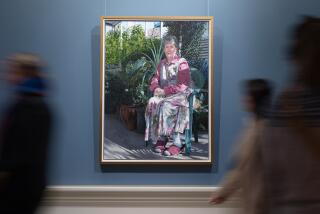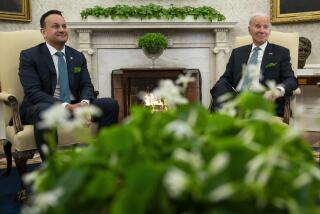Pub Crawl in Ireland Requires Stout Heart
- Share via
DUBLIN, Ireland — The man took a swig from his jar of Guinness and broke into a hearty grin.
“Oh, it was an honor for me, all right,” he said, “but not so unique. Brendan Behan drank with nearly everyone in Dublin. He tried to drink with all of them.”
We were sitting in a place called Just in Thyme, an unusual name for an Irish pub, as I found out later. The Irish rarely say “yes” or “no.” They reply in complete sentences. I learned all this on my first pint of Guinness.
During a pub crawl throughout Ireland, from Dublin to the Dingle Peninsula, and Galway to Killarney, I learned of the Irish mystique and culture from the people themselves. I was anxious to meet pub patrons from the rural countrysides, as well as the city folks.
I experienced the ineffable charm of the Irish pubs, which has moved the country’s great writers, poets and playwrights to describe them with utter fondness.
It was special, however, to meet someone who had bent elbows with that famous Irish playwright and writer, Brendan Behan.
Irish Pubs Are Different
But I still had to learn why Irish pubs were so popular and so different from their English counterparts, where I had spent a considerable amount of time and money.
“Well, if you will step outside,” said a grinning, red-haired chap sitting next to me in Durty Nelly’s, a famous pub in County Clare near Shannon Airport. For a moment I thought he might be inviting me out to fight. I recalled the Irish love for fighting, which is almost as much as their love for drinking.
To my relief, the man’s glass was firmly in hand as we walked out and gazed at the pub sign, set against the imposing backdrop of the gray keep of Bunratty Castle.
“You’ll be noticing,” said the man, “that the names of pubs in Ireland are nearly always personal, not like in England where the pubs are called the ‘Red Lion’ or the ‘Crown or the Rose,’ or some similar sort of historical name.
“Irish pubs are usually named for the owner or the proprietor, like ‘O’Malley’s Pub’ or ‘O’Sullivan’s’ or ‘Delaney’s,’ like that. And the pubs take on the personalities of the owners. As for Durty Nelly’s, well, let’s have a Guinness and think on that.”
The ambiance of an Irish pub is friendly. Ancient Irish codes of hospitality surface to welcome a stranger to the bar. There is none of the hushed tones and noticeable chill that may greet the foreigner invading an English pub, as if one had wandered into a private London club by mistake. Entering an Irish pub, I felt at home.
All About Guinness
“Home, I will not go!” declared one an obviously well-tanked local, earnestly trying to convey that his pub was also his home, and I was welcome. He was not about to go any place until he told me about Guinness.
Guinness is that heavy Irish stout, a brew that, while not invented in Ireland, was perfected here and taken to heart. It is the Irish national drink, along with Irish whiskey. Guinness is exported all over the world, but many drinkers insist that it doesn’t taste the same out of a bottle.
When drawn in an Irish pub, particularly through the old-style, wooden-handled pumps, Guinness is rich and creamy and has a slightly bitter flavor. Many Guinness drinkers favor the Guinness Extra Stout in the famous yellow-label bottles.
With its distinctive rich brown color and flavor that comes from roasted barley, this brew really is a stout. It was called “porter” after it became the favorite of the porters of the old Covent Garden in London in the 1700s.
You have to be a bit patient in an Irish pub after you order your Guinness. The ritual of filling the glass takes time, to let the foam settle and to top it off with a creamy collar that is sometimes called “the parish priest.”
This is the time to get acquainted with fellow patrons. While the hospitality of the Irish will soonmake you feel welcome, initially there is a certain reserve, a shyness that dates back to the origins of the Irish pub.
Unlike the coaching house inn that was the forerunner of the public house in England, the Irish pub evolved from a secret drinking place called the Shebeen. Like our Prohibition speakeasy, the Shebeen was an illegal gathering place for meeting, drinking and carousing.
Secret ‘Poteen’
In early times the drink was “poteen” or, more correctly, “poitin,” a spiritous homemade powerhouse distilled from barley. Like our mountain-made corn liquor, which carries a wallop even today, there is some poteen still made in secret places of Ireland, or so they say.
The Irish pub offers something special. Because of the Shebeen origin, where traditionally there was singing and dancing, the Irish pub frequently has full-fledged entertainment, with pipes, flutes, tin whistles and concertinas. And singing, of course.
The Irishman, like his Welsh neighbor, loves to sing and often has a good voice to boot. He may even dance an Irish jig.
Frequently, a casual drink at a neighborhood pub develops into an all-evening affair, complete with dinner and spontaneous entertainment.
The capacity of an Irishman to first drain a pint of Guinness, then immediately ask the publican to top it up again while beginning another song or dance seems nothing short of phenomenal. It is not unusual to chase this double pint with a half (shot) of Bushmill’s or Jameson’s or some other Irish whiskey.
They say whiskey comes from the Gaelic, Uisce Beatha (water of life). Bushmill’s claims to be the oldest distillery in the world, dating from 1608.
Impromptu Storytelling
In earlier times, in Irish pubs, there would be storytelling and recitations by Gaelic poets. Today there is storytelling of a more impromptu nature, embellished with leprechauns and wild Irish tales.
Mind you, the entertainment may mean you are part of it. You may be asked to sing a song, tell a story or, in any event, join in the evening fun. But Irish warmth will prevent embarrassing a guest. And think of the friends you will make.
The famous Welsh poet, Dylan Thomas, himself reputed to be one of the gargantuan drinkers of his day, recalled, “Once I drank 49 Guinnesses straight off and I came home on the top of a bus.”
If Thomas was not in Ireland for this feat, he should have been, for drinking gallons of Guinness is in the best Irish tradition.
Where does one find these wonderful pubs? They’ll probably find you. In a country of about 5 million people, Ireland had, at last count, nearly 11,000 pubs. One Irishman, when asked when the pubs closed, happily replied, “About November.”
On any corner in Ireland, there will be a “Patrick’s Pub” or a “Maloney’s Pub,” with a warm welcome, a brimming glass of Guinness and new friends. You may never learn the true Irish mystique, but you will have fun studying.
Mulligan’s is in downtown Dublin on Poolbeg Street, more than 200 years old, a place where writers congregate. Maybe a new Behan, Joyce or Shaw will show.
Famous Moby Dick
Peter’s Pub in Dublin, on Grafton Street, is another one I like. Moby Dick is a tavern on the quay in Youghal in County Cork, famous because it was the tavern shown in the film with Gregory Peck.
Then there’s Kate Kearney’s Cottage. If you hike over the Gap of Dunloe from Lord Brandon’s Cottage, Kilarney, a walking climb of 12 miles, you can rest outside this picturesque pub with a pint of Guinness, which you have earned. There are pony carts to take you home.
A pint of Guinness costs about 1.15 (approximately $1.50 U.S.). A half of Irish whiskey, equal to our full shot, is about the same. Scotch is 40 cents more.
The best hotels in Ireland usually cost about $150 double. But B&Bs; are everywhere at $15 per person with full Irish breakfast, surely the best bargain today. Besides, you get to meet the people . . . the ones you didn’t meet in the pubs.
More to Read
Sign up for The Wild
We’ll help you find the best places to hike, bike and run, as well as the perfect silent spots for meditation and yoga.
You may occasionally receive promotional content from the Los Angeles Times.






